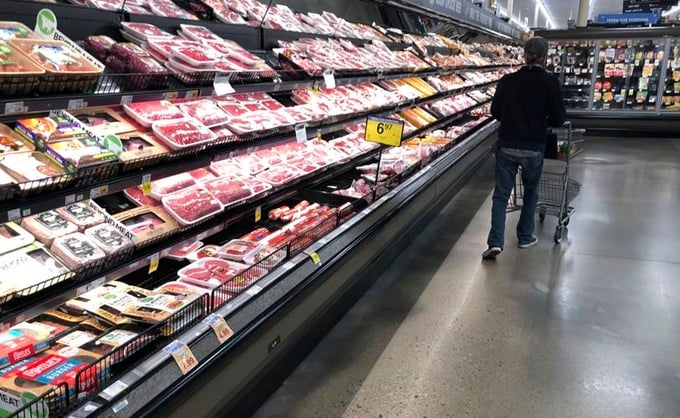June 6, 2025 | 17:47 GMT +7
June 6, 2025 | 17:47 GMT +7
Hotline: 0913.378.918
June 6, 2025 | 17:47 GMT +7
Hotline: 0913.378.918

One expert says: Don’t blame the grocery stores.
And the cost of food is rising even faster — in July, it hit 10.9%, the highest it has been since 1979.
One expert says: Don’t blame the grocery stores.
Tyler Renaghan is a vice president at Upside, a company that gives cash back to subscribers who shop at certain specific grocery stores, gas stations and restaurants. His specialty is grocery stores.
In an interview earlier this week, Renaghan said grocers have been hit by the same issues that have plagued the rest of the economy in America. But the ramifications are worse when dealing with fresh food.
The cost of “preparing a can of beans is not really changing very much. But it’s getting the food from the farm or from where it’s grown, and making sure that there’s enough drivers — there’s a driver shortage from a labor perspective. All of these things are negatively impacting that supply chain, especially on food,” he said.
Naturally, grocery stores pass along these increased costs to the consumer — but not all of the costs, Renaghan said. Some grocery stores are taking a hit to their bottom line in order to maintain customer loyalty, he said.
Grocery stores famously do not have much wiggle room when it comes to profits; they are known to operate on a razor-thin profit margin of just 1% to 2%. By keeping prices low enough to entice customers to continue coming through their doors, some grocery stores are dropping their profit margins to just 0.5% to 1%, figures that Renaghan said are not sustainable.
For years, many stores have used milk and eggs as loss leaders, charging less than the items actually cost in order to entice shoppers into the stores. Now, he said, some stores are expanding that concept to more products.
They are taking this additional hit “in order to keep their existing customers (coming) back to them in hopes that they also complete their grocery shop on some of the higher margin-type items.”
The competition to retain customers is becoming more intense, he said. In the recent past, many grocery shoppers would go to several stores for their food — one store for the best produce, another for the best meat and another for paper goods.
But now, Renaghan said, customers are consolidating their trips by shopping at fewer stores. And they are “trading down” their purchasing: They are buying cheaper versions of what they used to get. Instead of choice beef, they might buy select. Instead of a national brand of canned tomatoes, they might go for a private label brand.
The trend is playing itself out on a larger level as well. Higher-priced, premium food stores are seeing a reduction of business, while lower-priced and bargain food stores are seeing an increase.
Walmart, he said, is thriving.
The large grocery store chains are finding it easier to keep inflation at bay than small, neighborhood stores.
Neighborhood stores are often found in poorer areas that are not served by the larger chains. Because they typically charge higher prices, they are sometimes accused of exploitation.
Renaghan said the charge is usually unwarranted. Smaller markets are often family owned and have sometimes been at their location for multiple generations.
“They exist to serve their community. They don’t want to have to charge more than Schnucks, they don’t want to have to charge their local customers and their neighbors and their community higher prices than what they can get elsewhere. That’s not a good thing,” he said.
But smaller stores can’t avoid charging higher prices, and for several reasons.
“The local grocery store lacks the collective negotiation power to buy the product at a better price,” he said.
And the same problem, a simple matter of scale, also affects their labor costs.
Large chains have access to a deep pool of potential applicants and can find workers to cover every shift. Once they have hired the employees, they have programs to train them and a host of incentives, including attractive benefits, to retain them.
But at smaller stores, it is usually just the owner who has to do the hiring and the training. They can’t afford to offer the best benefits, so they typically have to pay somewhat higher salaries to their employees in order to keep them.
And while larger chains can offer private-label brands, which bring them a higher return, neighborhood stores are necessarily relegated to selling only higher-priced national brands.
So their prices go up even faster than at the large chains. The customers complain, and for good reason, but according to Renaghan there is nothing the stores can do about it.
(Stltoday)

(VAN) With the war ongoing, many Ukrainian farmers and rural farming families face limited access to their land due to mines and lack the financial resources to purchase needed agricultural inputs.

(VAN) Vikas Rambal has quietly built a $5 billion business empire in manufacturing, property and solar, and catapulted onto the Rich List.

(VAN) Available cropland now at less than five percent, according to latest geospatial assessment from FAO and UNOSAT.

(VAN) Alt Carbon has raised $12 million in a seed round as it plans to scale its carbon dioxide removal work in the South Asian nation.

(VAN) Attempts to bring down the price of the Japanese staple have had little effect amid a cost-of-living crisis.

(VAN) Fourth most important food crop in peril as Latin America and Caribbean suffer from slow-onset climate disaster.

(VAN) Shifting market dynamics and the noise around new legislation has propelled Trouw Nutrition’s research around early life nutrition in poultry. Today, it continues to be a key area of research.